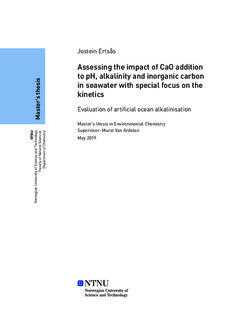| dc.contributor.advisor | Ardelan, Murat Van | |
| dc.contributor.author | Ertsås, Jostein | |
| dc.date.accessioned | 2019-09-26T14:00:14Z | |
| dc.date.available | 2019-09-26T14:00:14Z | |
| dc.date.issued | 2019 | |
| dc.identifier.uri | http://hdl.handle.net/11250/2619024 | |
| dc.description.abstract | Ocean Liming, OL er en foreslått teknologi der havet får mer alkalinitet fra tilførsel av CaO. Økt alkalinitet vil forsterke havets evne til å nøytralisere syre og dermed reversere havforsuring. Alkalinitet er sterkt knyttet til havets beholdning av uorganisk karbon og dens økte verdi forventes å komme fra atmosfærisk CO2. Denne studien ønsker å bedre forståelsen av mekanismene tilknyttet OL ved å måle pH, total alkalinitet, partikkelformasjon og utviklingen av ioner i løsning ved å studere to typer CaO (grov- og finkornet). Ved å sammenligne reaksjonshastigheten av forskjellige CaO-konsentrasjoner (0,01-, 0,015- og 0,02 g L-1) tyder det på at reaksjonen følger første orden. Omfanget av partikkelformasjon som inntreffer de første 10-20 minuttene er relatert til mengde CaO tilført. Grad av partikkelformasjon som inntreffer er viktig i en OL-sammenheng da det kan føre til biologiske konsekvenser. Den totale endringen i pH og alkalinitet er sammenlignbar for forskjellige typer CaO, men den grovkornede reaksjonshastigheten er langsommere og danner kun i liten grad partikler de første 10-20 minuttene. Total alkalinitet økte 1,68 mol per mol CaO tilført (0,01 g L-1 fin CaO), men potensialet for OL til å isolere CO2 i havet bør undersøkes i sammenheng med konstant pCO2. OL sitt globale bidrag til å fjerne CO2 i atmosfæren er imidlertid tett knyttet til mengde CaO anvendelig, samt karbonfangstteknologi, utslipp fra gruvedrift, transport og oppvarming. OL kan imidlertid være en mulig løsning til å reversere havforsuring. | |
| dc.description.abstract | Ocean liming, OL is proposed as a geoengineering technic with the intention to artificial increase ocean alkalinisation. Enhanced alkalinity will increase the acid neutralizing capacity and thereby reverse ocean acidification. The increased alkalinity is predicted to originate from CO2, making OL a tool to sequester atmospheric CO2. This study tries to clarify the mechanisms taking place in OL by measuring pH, total alkalinity, particular formation and actual ions development using two types of CaO (coarse and fine). From comparing rate for different concentrations of fine CaO (0.01-, 0.015- and 0.02 g L-1) the reaction rate appears to follow first order. The extent of particular formation which unfolds the first 10-20 minutes after an addition is related to CaO dose. The magnitude of the formation could be important in OL contexts as it might cause biological consequences. The absolute pH and alkalinity for different grain size CaO is comparable, but coarse grained showed a slower reaction rate and only a small immediate peak of precipitation. Total alkalinity increased 1.68 mole per mole CaO (0.01 g L-1 fine CaO), but OL potential to sequester CO2 should be investigated further in an open system experiment with constant pCO2. OL’s global contribution in removing CO2 is however closely linked to the scale of production as well as carbon capture technologies, emissions from mining, transportations and heating. OL can however be a possible solution to reverse ocean acidification. | |
| dc.language | eng | |
| dc.publisher | NTNU | |
| dc.title | Assessing the impact of CaO addition to pH, alkalinity and inorganic carbon in seawater with special focus on the kinetics | |
| dc.type | Master thesis | |
